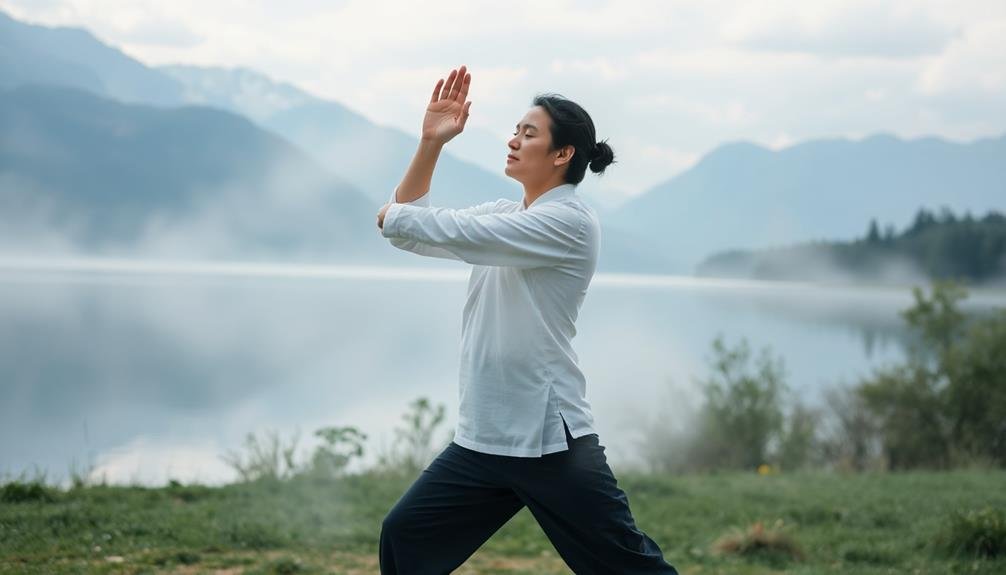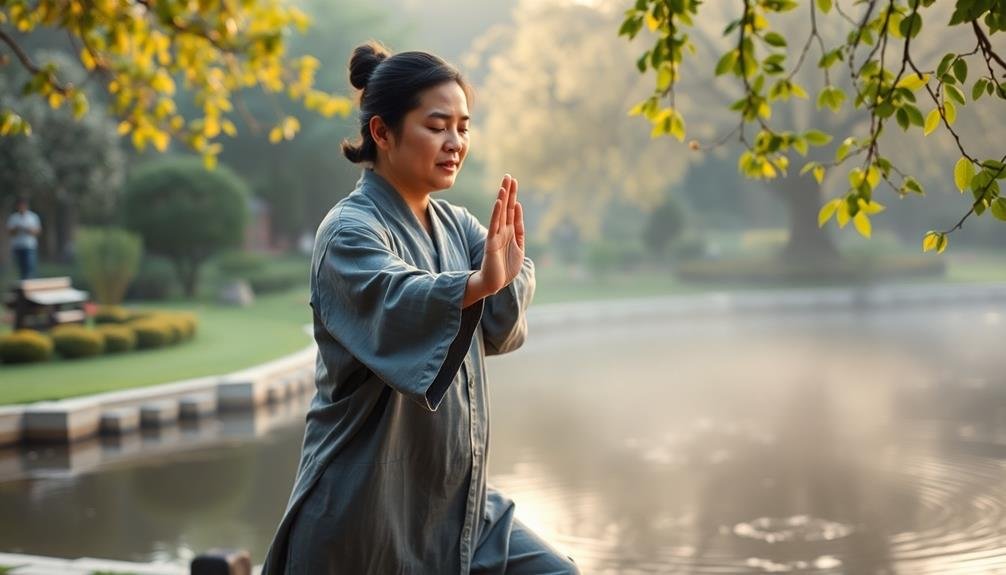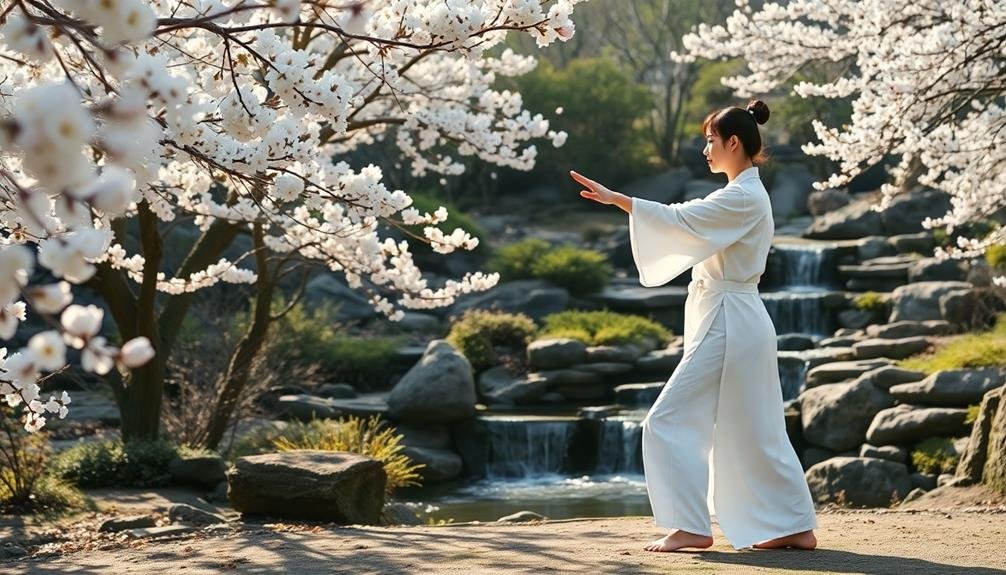To ease anxiety naturally with Tai Chi, start by practicing mindful breathing, focusing on deep inhalations and slow exhalations. Master the standing meditation pose, known as "Wuji," to improve balance and release tension. Embrace slow, fluid movements synchronized with your breath, moving as if through water. Cultivate body awareness by regularly scanning for tension and observing muscle engagement during practice. Finally, create a peaceful environment with soft lighting, soothing scents, and gentle background sounds. These five Tai Chi tips can help you reduce stress and promote relaxation in your daily life. Discover how these ancient techniques can transform your approach to managing anxiety.
Practice Mindful Breathing

Serenity begins with each breath. In Tai Chi, mindful breathing is the foundation for calming your mind and reducing anxiety. As you practice, focus on your breath, inhaling deeply through your nose and exhaling slowly through your mouth. Feel your lungs expand and contract with each breath, allowing tension to melt away.
To enhance your mindful breathing, try counting your breaths. Inhale for a count of four, hold for two, then exhale for six. This rhythm helps regulate your nervous system and promotes relaxation. As you breathe, imagine drawing in positive energy with each inhalation and releasing stress with each exhalation.
Incorporate mindful breathing into your daily routine, not just during Tai Chi practice. When you're feeling anxious, take a moment to center yourself with a few deep breaths. You can do this anywhere – at work, in traffic, or before a stressful situation.
Master the Standing Meditation Pose
The foundation of Tai Chi's anxiety-relieving power lies in the standing meditation pose. Also known as "Wuji" or "Wu Chi," this stance forms the basis for all Tai Chi movements. To master it, start by standing with your feet shoulder-width apart, knees slightly bent. Let your arms hang loosely at your sides, palms facing your thighs. Imagine a string pulling the crown of your head upward, elongating your spine. Relax your shoulders and soften your gaze.
As you hold this pose, focus on your breath and body awareness. You'll likely notice tension in various areas. Consciously release this tension, starting from your head and working down to your toes. Aim to hold the pose for 5-10 minutes initially, gradually increasing the duration as you become more comfortable.
| Benefits | Common Mistakes | Corrections |
|---|---|---|
| Improves balance | Locking knees | Keep knees slightly bent |
| Reduces muscle tension | Holding breath | Breathe naturally |
| Enhances body awareness | Rigid posture | Allow gentle sway |
Practice the standing meditation pose daily to build a strong foundation for your Tai Chi practice and anxiety management. You'll soon notice improved stability, both physically and mentally.
Embrace Slow, Fluid Movements

Building on the foundation of the standing meditation pose, you're now ready to explore the hallmark of Tai Chi practice: slow, fluid movements. These graceful motions are designed to promote relaxation, improve balance, and reduce anxiety.
Start by focusing on your breath as you begin to move. Inhale deeply as you raise your arms, and exhale slowly as you lower them. Keep your movements smooth and continuous, as if you're moving through water. This mindful approach helps quiet racing thoughts and brings your attention to the present moment.
Pay attention to the transfer of weight between your feet as you shift your body. This awareness enhances your sense of grounding and stability. As you practice, imagine energy flowing through your body, following the path of your movements.
Don't rush through the motions. The slow pace of Tai Chi allows you to fully experience each movement and its effects on your body and mind. This deliberate practice cultivates patience and mindfulness, which are valuable tools for managing anxiety.
Focus on Body Awareness
During Tai Chi practice, heightening your body awareness is essential for reducing anxiety and promoting relaxation. As you move through each posture, focus on how your body feels and responds to the movements. Pay attention to the sensation of your feet connecting with the ground, the alignment of your spine, and the positioning of your limbs.
To enhance your body awareness during Tai Chi:
- Scan your body regularly, noticing areas of tension or discomfort
- Concentrate on your breath, feeling it move through your body
- Observe how your muscles engage and release with each movement
By cultivating this heightened awareness, you'll become more attuned to physical sensations and better able to recognize signs of stress or anxiety. This increased mindfulness allows you to address tension before it escalates, helping you maintain a calmer state of mind.
As you practice, you'll likely notice improved posture and balance. These physical benefits can contribute to reduced anxiety by boosting your confidence and sense of control.
Cultivate a Peaceful Environment

Creating a serene atmosphere for your Tai Chi practice can greatly enhance its anxiety-reducing effects. Start by choosing a quiet space where you won't be disturbed. This could be a corner of your home, a peaceful outdoor area, or even a dedicated room if you have one.
Ascertain the area is clean and clutter-free to minimize distractions and promote a sense of calm.
Adjust the lighting to suit your preferences. Soft, natural light is often ideal, but you might prefer dimmed artificial light if you're practicing in the evening.
Consider using candles or essential oil diffusers to add a soothing scent to your environment. Lavender, chamomile, or sandalwood can be particularly calming.
Play gentle background music or nature sounds if you find it helpful. Many people enjoy the sound of flowing water or soft instrumental melodies during their practice.
Keep the volume low so it doesn't overpower your focus on breathing and movement.
Lastly, choose comfortable, breathable clothing that allows for easy movement.
Frequently Asked Questions
How Long Does It Take to See Anxiety-Reducing Benefits From Tai Chi?
You'll likely notice anxiety-reducing benefits from tai chi within a few weeks of consistent practice. However, everyone's experience differs. You might feel calmer after just one session, but long-term effects typically develop over several months of regular practice.
Can Tai Chi Be Practiced by People With Physical Limitations or Injuries?
You can practice tai chi with physical limitations or injuries. It's adaptable to various abilities. Consult your doctor first, then work with a qualified instructor who'll modify movements to suit your needs. Start slowly and listen to your body.
Are There Specific Tai Chi Forms Recommended for Anxiety Relief?
Yes, there are specific Tai Chi forms for anxiety relief. You'll find "Yang style" particularly beneficial. Try "Cloud Hands" and "Embrace the Moon" movements. They're gentle, flowing exercises that'll help calm your mind and reduce stress.
How Often Should I Practice Tai Chi for Optimal Anxiety Management?
You'll benefit most by practicing Tai Chi daily for 20-30 minutes. If that's not possible, aim for at least 3-4 sessions per week. Consistency is key, so find a routine that works for you and stick with it.
Can Tai Chi Be Combined With Other Anxiety Treatments or Medications?
Yes, you can combine tai chi with other anxiety treatments or medications. It's often used as a complementary therapy. Consult your healthcare provider to verify it's safe and to create an integrated approach for managing your anxiety effectively.
In Summary
You've now learned five powerful tai chi techniques to combat anxiety naturally. By incorporating mindful breathing, mastering the standing meditation pose, embracing fluid movements, focusing on body awareness, and cultivating a peaceful environment, you're well-equipped to reduce stress and find inner calm. Remember, consistency is key. Practice these tips regularly, and you'll soon notice a significant improvement in your overall well-being. Don't hesitate to start your tai chi journey today – your mind and body will thank you.





Leave a Reply